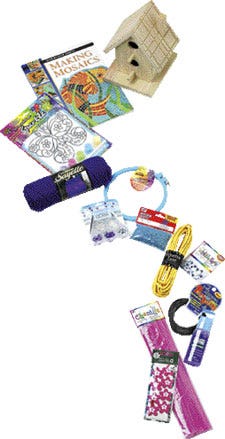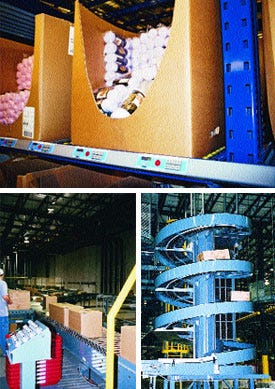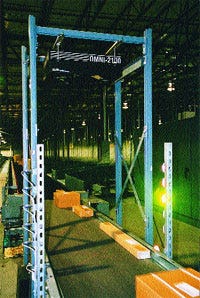Michaels' automated DC is a work of art
January 29, 2014
 Whether you attribute it to society's increasing focus on home-based, family activities, a more affluent baby-boomer population, the rising trend of crafting as a second form of household income, or the popularity of home decorating shows, the do-it-yourself arts and crafts business is booming. And perfectly positioned to take advantage of consumers' growing desire to express themselves through crafting and decorating is Irving, TX-based Michaels Stores, Inc. Michaels operates approximately 820 retail outlets in North America and reached $3.091 billion in sales in 2003, achieving its seventh consecutive year of record sales and earnings.
Whether you attribute it to society's increasing focus on home-based, family activities, a more affluent baby-boomer population, the rising trend of crafting as a second form of household income, or the popularity of home decorating shows, the do-it-yourself arts and crafts business is booming. And perfectly positioned to take advantage of consumers' growing desire to express themselves through crafting and decorating is Irving, TX-based Michaels Stores, Inc. Michaels operates approximately 820 retail outlets in North America and reached $3.091 billion in sales in 2003, achieving its seventh consecutive year of record sales and earnings.
In May 2002, anticipating a growth in the number of its stores in the Northeastern U.S., Michaels began operating a new 692,000-sq-ft regional distribution center equipped with state-of-the-art material handling systems from FKI Logistex. Automatically replenishing 163 area stores with basic merchandise and supplying 217 stores with seasonal items, the new facility is craftily devised to handle approximately 16,500 stockkeeping units (skus), expandable to 26,000 skus, with 99.5-percent accuracy.
"One of the company's initiatives is to convert more of the skus that go store-direct to DC replenishment merchandise," explained Mike Camp, general manager for the Hazleton facility, during a recent PD visit. "That's why this building was designed for sku growth."
|
Upon RF scanning of the license plate, the slots containing a pick light up and indicate the number of items to be picked and packed. Operators then pick the items and place them in a case onto which they have adhered the license plate. |
At present, Michaels stores offer nearly 40,000 items, dominating d?cor categories such as ribbon, silk and dried floral materials, art supplies, and custom and ready-made framing in 48 U.S. states and in Canada. The company also operates 158 Aaron Brothers framing and art supply stores across the U.S. that carry an average of 5,700 skus, and has recently launched two Dallas-area scrapbooking and paper crafting stores called ReCollections.
State-of-the-art system
Situated along a densely wooded corridor of newly constructed industrial facilities in Eastern Pennsylvania, Michaels' Hazleton DC offers plenty of opportunity for growth. Providing room for expansion up to 1 million sq ft, the building is equipped to sustain 24/7 operations, if needed. Currently the facility, one of seven Michaels' DCs in the U.S., runs two shifts daily, five days a week.
The DC's automated fulfillment system is the result of a collaboration between Keogh Consulting, an engineering firm specializing in the planning and design of modern distribution systems, and the FKI Logistex Distribution Team. Streamlined and robust, the system maximizes efficiency and cost savings, increases accuracy, and provides Michaels' employees with a safe and quiet working environment, says John Westendorf, CEO of FKI Logistex Automation Division.
Highlights of the fulfillment system include the EASYpick® Trak Light picking system, running on Outbound Productivity Suite™ (OPS) software from FKI's Real Time Solutions, and the FKI Logistex UniSort® X sliding shoe sorter directed by FKI's BOSS™ PC-based control system. The facility houses 5.5 miles of conveyor, including belt and transportation conveyors, accumulation conveyors incorporating FKI's photoeye, sensor-equipped Accuglide technology, and four spiral conveyors from Ryson Intl.
A key benefit to the Hazleton installation is the ability of EASYpick OPS to take a download from the DC's warehouse management system (WMS), supplied by RedPrairie?, and after picking, hand the orders to the BOSS sortation control software. "At the time we selected our order-fulfillment system, our Alliance, Texas, and Lancaster, California, distribution centers were using FKI Systems," recalls Camp. "Real Time Solutions OPS, which is our pick-to-light system, has a proven interface with the BOSS system. BOSS also has a proven interface with our WMS. Those factors, coupled with a solid product, competitive pricing and a commitment to project management, made FKI Logistex the choice for this operation."
Streamlined replenishment
Among the products distributed from the Hazleton facility are items sourced domestically and from import vendors. When products arrive at the DC in either truckload or less-than-truckload quantities, the truckers' paperwork is matched with an original purchase order on the facility's WMS, and the items are entered into the system. Unloaded from the trucks, products are received and accounted for through radio frequency (RF) scanning of UPC bar codes. After scanning, pallets of product receive a label that acts as an identifier, and the products are automatically sent to their pick location.
|
Some pick locations, top, utilize multiple faceplates where larger products or quantities are held. Leading to a single shipping sorter, a saw-tooth merge, above left, is fed by six lanes. Spiral conveyors, above right, carry full-case items to the upper level of the pick module. |
Replenishment orders for the regional stores that the Hazleton facility serves are generated through a corporately located Auto Replenishment System (ARS) that is driven by point-of-sale sales data. The orders are based on a minimum-maximum presentation quantity, up-to-date sales forecasts, and Michaels' current promotional activities. Each store generally receives basic replenishment deliveries from the DC once a week, which means that the Hazleton facility processes an average of 15 delivery truckloads per day.
Ensuring that the DC has enough merchandise in stock to service these stores is the responsibility of Michaels' corporate inventory management department. "Our replenishment systems keep an inventory history–movement history, item history, etc.–along with vendor lead times so that they know how many weeks supply we need to have on hand so we can keep those items in stock," explains Camp.
Pick-and-pass increases productivity
Each day, the Hazleton DC pulls into its WMS system the orders for stores scheduled for replenishment that day. "Once it downloads into our WMS, we'll 'wave-plan' it using OPS, which means we'll set the stores up to be order-selected in a particular sequence, and then we'll fill the orders," says Camp.
Orders are filled either by pick-to-light, for less-than-case orders, or by pick-to-label for full-case quantities. Camp relates that repack orders account for a larger percentage of the facility's work. Although, he adds, during the third- and fourth-quarter peak seasons, a lot of orders "push up" to full-case quantities.
Encompassing four stories, the repack module has 15,000 faceplates, or pick locations, positioned on Unarco racking. Some pick locations utilize multiple faceplates where larger products or quantities are held, explains Dave Brennan, facilities and operations manager for the Hazleton facility. Part of the EASYpick Trak Light picking system from Real Time Solutions (RTS), the faceplates are modular, cable-less units that snap in at the pick face. Chosen by Michaels over traditional cabled light systems, EASYpick units are menu-driven smart systems that can communicate with a single controller for faster message transmission throughout the entire order-management network.
The OPS software system provides visibility throughout the picking process. From a single user interface, the online OPS order control screen offers system-wide access for diagnostics, dynamic updating of modifications to run time parameters, efficiency loads, real-time tracking statistics, as well as historical tracking to aid in preventive maintenance.
|
Completed repack orders convey to a print-and-apply labeler that matches the case's license plate with actual shipping information, which is printed via a thermal-transfer printhead. |
Order picking is initiated when an operator pulls a generic "license plate" off a roll of labels and RF scans the label to bring up order information from EASYpick. A store-specific replenishment order with all its relevant information is then associated with that generic license plate. Upon RF scanning of the license plate, or "lpn," the slots containing a pick light up and indicate the number of items to be picked and packed.
Operators then pick the items and place them in a case onto which they have adhered the license plate. Once all picks for that location are completed, the operator places the case on a conveyor running down the center of a pick aisle. Orders are then conveyed and, through the use of FKI's BOSS routing-control system, are diverted to the next zone that contains picks for that order.
Case routing is initiated by photoeye sensors at each zone that read the license plates and determine if the box is still systematically open and should be diverted to the next zone or should continue through the pick module. The DC's zones are organized according to Michaels' retail-store departments, making it easier for the stores to restock merchandise upon receipt of their order. According to Brennan, there are 32 transfers in the system where a case can potentially be diverted.
Slower-moving items are positioned near the end of the picking line in static shelving that uses multilocation lights that serve multiple slots. When cases are closed or full, they move to the end of the picking line where they are audited by an operator who scans the license plate, calling up the order on a PC, and checks the contents of the case against the order.
After being audited, repack orders are transported by conveyor to one of two Model 250 RH print-and-apply tamp labelers from ID Technology. Before label application, a scanner reads the license plate to identify the order and coordinate it with shipping information. A label is then printed with the wave number, the store number, and the bar code by a Zebra 110 Pax3 thermal-transfer printhead and is applied to the top of the carton. Only one printer runs at any given time, so that the line does not have to be shut down to reload label stock.
Sortation at 350 fpm
Full-case picking is accomplished manually. An operator scans a label with the picking information using an RF gun, which then instructs them on the location and quantity of the pick item. Once the full case is picked, the shipping label is attached, and the case is placed on a conveyor. Ryson spiral conveyors move the product to the upper levels of the pick module.
|
As labeled cases from six different lanes merge into one, they pass under a scanner that reads the label bar code and determines into which shipping lane the case should be diverted. |
The product exits the pick module and moves to a central, saw-tooth merge. The merge uses FKI's Accuglide photoelectric accumulation conveyor technology, which uses powered-roller, zero-pressure accumulation to provide equal spacing between cases to eliminate product damage and jams.
Leading to a single shipping sorter, the merge is fed by six lanes, including those carrying labeled repack items as well as a recirculating lane that accommodates the overflow of cases that occurs when the shipping lane is full. Cases that have a damaged or missing label, or cases that are not in the current wave being sorted, will divert on a "no read" line.
The sorting process is directed by the BOSS software system. As cases from the six lanes merge into one, they pass under an Omni-2100 scanner from SICK that reads the label bar code and determines into which shipping lane the case should be diverted. The bar code also tells the sorting system, FKI's UniSort X sliding shoe sorter, the size of the case and the number of shoes that will be required to divert it.
During operation of the sliding shoe sorter, cases are transported over the sorter on round tubes fitted with sliding shoes. The shoes are guided by a track on both sides of the sorter. Divert switches interrupt the track at predetermined points. Divert switches release the needed number of 5-in.-wide shoes to move a given carton. Driven by air, the shoes slide diagonally across the carrying slats, creating a moving wall that positively and gently slides the case off the sorter and into the appropriate shipping lane. According to Brennan, the sorting conveyor operates at 350 ft/min, well under its top-rated speed of 550 fpm. "We've found that there are less problems at a slower speed, and that still accommodates our throughput," he explains.
The sorting system feeds 18 lanes, 16 of which are fluid loading lanes that lead directly into trailer trucks. The balance is palletization lines, used for pallet loads of new store orders. The system also has a "jackpot lane" that handles orders that are not part of a wave but have been specially ordered by a store outside of the current wave.
Making sure that everything originally scheduled for shipping that day has made it to a trailer is the job of the Omni-2100 scanner. "Once you finish the wave, but before you ship the orders, you will get an exception report because the system knows what orders it generated, and the scanner knows what it saw," explains Camp. "Anything that is missing, you have to research and resolve before you invoice the stores."
System meets expectations
In March 2002, Michaels began stocking the Hazleton facility, and two months later, the first outbound orders were shipped. According to Kim Baudry, southeastern regional manager of RTS, the ease of use of the installed picking system is evident in the speed with which the operation was able to get up and running. "We typically have new employees trained in a day, and certainly within two weeks after implementing this system, the DCs are hitting their target output," she says.
|
During operation of the sliding shoe sorter, divert switches interrupt the track at predetermined points and release the needed number of 5-in.-wide shoes to move a given carton. |
The greatest challenge for Michaels, she relates, is the sheer variety and volume of items handled. "They carry everything from pipe cleaners and popsicle sticks to art canvases and picture frames," she says. "They can have situations where they are picking just one item out of a bag of 1,000."
"It's challenging mostly from the perspective of slotting the merchandise," she adds.
Using the tools provided by its picking system software, as well as its WMS and sorting solutions, Michaels' Hazleton facility is achieving a fill rate of 99.6 percent for in-stock skus and an on-time delivery rate of 98.6 percent.
Relates Camp, six months after startup, the Hazleton facility was, and remains, the most productive of the Michaels network DCs.
More information is available:
Fulfillment system integration: FKI Logistex Distribution Team, 877/935-4564. www.fkilogistex.com. Circle No. 226.
Fulfillment system design: Keogh Consulting, 561/775-3833. www.keogh1.com. Circle No. 227.
Pick-to-light system, picking software: FKI Logistex Real Time Solutions, 510/985-6300. www.picktolight.com. Circle No. 228.
Sliding shoe sorter, sortation software, accumulation conveyor, transportation conveyors: FKI Logistex Buschman, 877/935-4564. www.fkilogistex.com/automation/buschman/. Circle No. 229.
Warehouse management system: RedPrairie, 877/733-7724. www.redprairie.com. Circle No. 230.
Picking racks: Unarco Material Handling, Inc., 800/862-7261. www.unarco.net. Circle No. 231.
Print-and-apply labelers: ID Technology Corp., 888/438-3242. www.idtechnology.com. Circle No. 232.
Thermal-transfer printhead: Zebra Technologies Intl. LLC, 800/423-0422. www.zebra.com. Circle No. 233.
Spiral conveyor: Ryson Intl., Inc., 757/898-1530. www.ryson.com. Circle No. 234.
Scanner: SICK, Inc., 800/325-7425. www.sick.com. Circle No. 235.
About the Author(s)
You May Also Like







